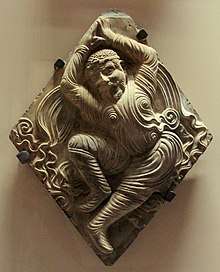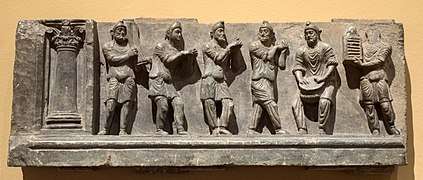Huteng
Huteng (simplified Chinese: 胡腾; traditional Chinese: 胡騰; pinyin: Húténg; lit.: 'Barbarian leap', also 胡腾舞, Húténgwǔ, "Dance of the Barbarian leap") was the Chinese term for a type of dance that originated in Central Asia, especially among the Sogdians and the region of Tashkent (石國, Shíguó).[1] The dance was well known during the Tang dynasty, and there are numerous depictions of it in works of art. The dance was characterized by spinning, leaps and backflips.[1] The dancers would particularly make summersaults, first planting their feet firmly on the carpet, tilting their face upward and arching their body, then lift their arms and jump backward to the sound of flutes and the pipa.[2]

Another famous dance from Central Asia was the Sogdian Whirl (胡旋, Húxuăn, "Whirling Barbarian", also 胡旋舞, Húxuănwǔ, "Dance of the Whirling Barbarian"), in which a young woman was spinning inside a circle.[1] Also another one was the "Dance of the thorn branch" (柘枝舞, Zhèzhīwŭ).
These dances, part of the "Barbarian dances" (胡舞, Húwŭ) from Central Asia, Serindia and the Persian Empire, were extremely popular in China during the Tang Dynasty, especially in the area of Chang'an and Luoyang.[1][3]
The representations of foreigners would turn more negative after the 8th century CE, following the revolt of An Lushan, a Turco-Iranian rebel.[4]

.jpg) Left: a man holding a plate of fruits; right: a bearded man is performing the Huteng dance. Both figures have haloes. Tomb of Yu Hong, 6th century CE.
Left: a man holding a plate of fruits; right: a bearded man is performing the Huteng dance. Both figures have haloes. Tomb of Yu Hong, 6th century CE.
See also
- Sogdian Whirl
- Iranians in China
- Tomb of Yu Hong
References
- The Silk Road Encyclopedia. Seoul Selection. 2016. p. 778. ISBN 9781624120763.
- Trombert, Éric; Vaissière, Étienne de La (2005). Les sogdiens en Chine. École française d'Extrême-Orient. p. 96. ISBN 9782855396538.
- China Archaeology and Art Digest. Art Text (HK) Limited. 1997. p. 3.
- Cosmo, Henry Luce Foundation Professor of East Asian Studies Nicola Di; Cosmo, Nicola Di; Wyatt, Don J. (2005). Political Frontiers, Ethnic Boundaries and Human Geographies in Chinese History. Routledge. p. 135. ISBN 9781135790950.